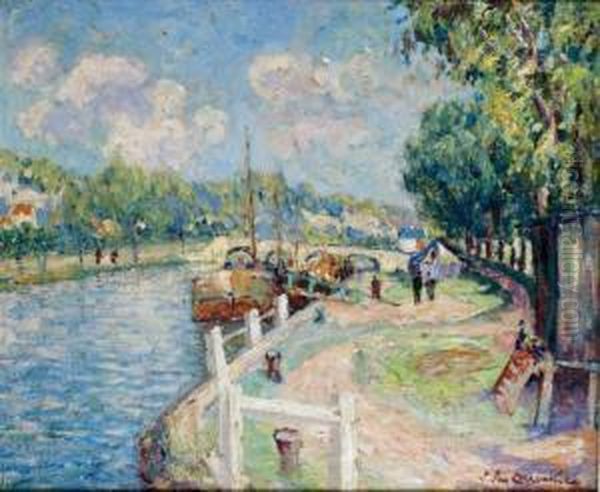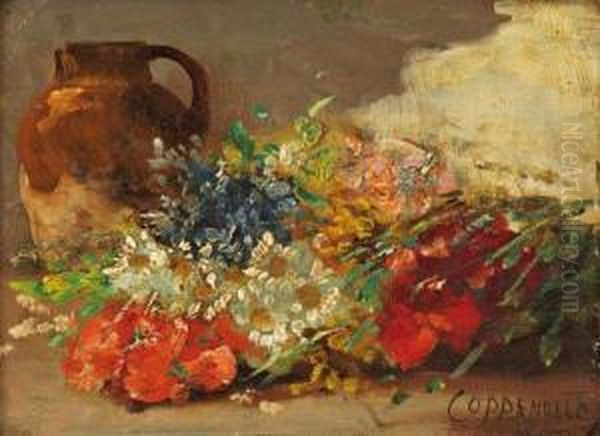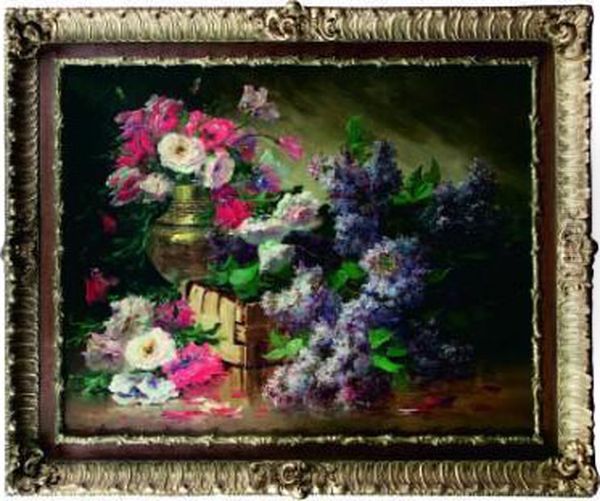Jacques Van Coppenolle, an artist whose life spanned the vibrant cusp of the 19th and 20th centuries, remains a figure of quiet intrigue in the annals of art history. Active primarily as a painter, his oeuvre, though not as extensively documented as some of his more famous contemporaries, offers a charming window into the artistic currents of his time, particularly his dedication to floral subjects and evocative landscapes. Born in 1878 and passing away prematurely in 1915, his career was tragically short, yet the works that survive speak to a sensitive eye and a skilled hand, navigating the rich traditions of still life and landscape painting with a touch of modern sensibility.
The information available on Van Coppenolle suggests an artist deeply connected to the natural world, with a preference for oil on canvas and a consistent practice of signing his works, often in the lower right corner. His paintings, frequently featuring flowers, river scenes, and glimpses of rural life, position him within a lineage of artists who found profound beauty in the everyday, rendered with an appreciation for light, color, and atmosphere.
Birth in an Artistic Haven: Montigny-sur-Loing
A crucial piece of information regarding Jacques Van Coppenolle is his birthplace: Montigny-sur-Loing, in the Seine-et-Marne department of France. This detail is significant, as Montigny-sur-Loing, nestled near the Forest of Fontainebleau, was a notable artists' colony, attracting painters since the mid-19th century. It was part of the broader orbit of the Barbizon School, which had revolutionized landscape painting by emphasizing direct observation of nature and plein air (outdoor) work. Artists like Jean-Baptiste-Camille Corot, Jean-François Millet, and Théodore Rousseau had earlier sanctified the Fontainebleau region as a site of artistic pilgrimage.

The Loing River itself, which flows through Montigny, was a favored subject for many painters, including the Impressionist Alfred Sisley, who spent a significant portion of his career capturing its gentle beauty in nearby Moret-sur-Loing. To be born and likely spend formative years in such an environment would have undoubtedly exposed a young, artistically inclined individual like Van Coppenolle to a rich tapestry of artistic activity and a deep appreciation for landscape. While often referred to as a Belgian artist, perhaps due to his surname or family heritage, his French birthplace firmly roots his early experiences in this artistically fertile region of France.
Potential Familial and Early Artistic Influences
The name Van Coppenolle resonates with another artistic figure, Edmond Van Coppenolle (variously dated 1843/1846 – 1914). While the exact familial relationship to Jacques is not always explicitly stated in easily accessible records, the shared surname, artistic profession, and overlapping period of activity suggest a strong likelihood of a close connection, possibly father and son. Edmond Van Coppenolle was himself a painter of note, particularly recognized for his lush floral still lifes and, like Jacques, was associated with Montigny-sur-Loing.
Edmond is documented as having moved to Paris and studied under Ernest Quost (1842-1931), a respected painter known for his vibrant flower pieces and landscapes, who himself exhibited regularly at the Paris Salon. Quost's style, characterized by rich impasto and a bright palette, often verging on Impressionism, would have been a significant influence. If Jacques was indeed Edmond's son or a close relative, it is highly probable that he received early artistic guidance within the family and was exposed to the teachings and style of artists like Quost. This connection provides a plausible pathway for Jacques's own artistic development, steeping him in the traditions of floral painting while also exposing him to the more modern, light-filled approaches prevalent in late 19th-century Paris.
The artistic environment of Paris during Jacques Van Coppenolle's formative years was a crucible of innovation. Impressionism had already made its mark, with artists like Claude Monet, Pierre-Auguste Renoir, and Camille Pissarro having redefined the way light and momentary effects were captured. Post-Impressionist movements were also taking hold, with figures such as Vincent van Gogh (though deceased by 1890, his influence was growing), Paul Cézanne, and Paul Gauguin pushing the boundaries of form, color, and expression. While Van Coppenolle's known work appears more aligned with a gentler Impressionism or a refined naturalism, the air was thick with artistic experimentation.
Thematic Focus: Flowers, Rivers, and Rural Life
Jacques Van Coppenolle’s artistic identity is most strongly associated with his depictions of flowers and landscapes. This thematic preference places him in a long and distinguished tradition, yet his approach seems to have incorporated contemporary stylistic nuances.
The Enduring Allure of Floral Painting

Flower painting, a genre with deep roots stretching back to the Dutch Golden Age masters like Jan van Huysum and Rachel Ruysch, experienced a resurgence in popularity in the 19th century. Artists like Henri Fantin-Latour created exquisite, almost photographically precise floral arrangements, while Impressionists like Monet and Renoir explored flowers for their chromatic brilliance and textural possibilities, often in garden settings or as part of broader compositions.
Van Coppenolle’s floral works, such as Bouquet de fleurs tricolore (Tricolor Bouquet of Flowers), Roses et lilas (Roses and Lilacs), and Les giroffées (likely referring to wallflowers or stocks), suggest a keen observational skill and a delight in the varied forms and colors of botanical subjects. The influence of 17th-century Dutch masters is noted in some descriptions of his style, likely referring to the careful arrangement and detailed rendering of blooms. However, this traditional foundation appears to be overlaid with an Impressionistic sensibility, evident in a freer brushstroke, an emphasis on light, and a vibrant palette that captures the freshness of the flowers. His work in this genre would have found a receptive audience, as floral still lifes were popular decorative items and appreciated for their beauty and technical skill.
Capturing the Spirit of the Loing
His landscape paintings, particularly those featuring river scenes, connect him to another significant artistic trend. The work titled Péniches amarrées sur le Loing (Barges Moored on the Loing), dated by some sources to 1915, the year of his death, is a poignant example. The Loing River, as mentioned, was a muse for many artists. Charles-François Daubigny, a key Barbizon figure, was famous for his river landscapes, often painted from his studio boat, capturing the tranquil waters and verdant banks of French rivers. Alfred Sisley, perhaps the most dedicated Impressionist painter of the Loing, created numerous views of the river and its surrounding towns, emphasizing the subtle shifts in light and atmosphere.
Van Coppenolle’s depiction of barges on the Loing would likely have shared this interest in capturing a specific sense of place and time. Such scenes often evoke a quiet, contemplative mood, reflecting the gentle flow of water and the play of light on its surface. The presence of péniches, traditional French canal barges, adds a human element, hinting at the commercial and daily life along the waterways. His technique in these landscapes probably balanced descriptive detail with an Impressionistic concern for overall effect, light, and color harmony.
Scenes of Rural Charm

Works like Poules et Coqs (Hens and Roosters) and Le Poulailler (The Henhouse) indicate an interest in rural and farmyard scenes. This theme also has strong connections to the Barbizon School, whose artists often depicted peasant life and agricultural landscapes with a sense of dignity and realism. Jean-François Millet is the quintessential painter of rural labor, but many others, including Constant Troyon, known for his animal paintings, contributed to this genre. Van Coppenolle’s approach to these subjects was likely less about social commentary and more focused on the picturesque charm and vibrant life of the farmyard, rendered with the same attention to naturalistic detail and lively color seen in his other works. A general Nature morte (Still Life) is also attributed to him, suggesting a broader engagement with the still life genre beyond exclusively floral subjects.
Artistic Style: A Blend of Tradition and Modernity
Assessing Jacques Van Coppenolle's style requires piecing together observations from his known works and the artistic context he inhabited. He appears to have been an artist who, while respectful of tradition, particularly the meticulousness of Dutch Golden Age still life, was also responsive to the innovations of his time, notably Impressionism and the legacy of the Barbizon School.
The Barbizon influence would be evident in his commitment to natural subjects, whether landscapes or floral arrangements, and potentially in an element of plein air practice, especially for his landscape studies. The emphasis on direct observation and capturing the authentic character of a scene or subject is a hallmark of this movement.
The Impressionistic aspects of his style would manifest in several ways:
1. Light and Color: A brighter palette than that of earlier academic painters, with an interest in how light affects the appearance of objects and creates atmosphere. This might involve the use of broken color or juxtaposed complementary colors to create vibrancy.
2. Brushwork: While perhaps not as radically broken as in the work of Monet or Pissarro, a more visible, expressive brushstroke than in highly finished academic works would be characteristic, lending texture and immediacy to his paintings.
3. Atmosphere: A concern for capturing the overall mood and atmospheric conditions of a scene, particularly in his landscapes.
His floral paintings, described as being influenced by 17th-century Dutch masters yet employing an "Impressionistic manner," suggest a synthesis. He might have adopted the rich detail and careful composition of the Dutch tradition but infused it with a more modern sensibility regarding light, color, and painterly application. This blend was not uncommon; artists like Fantin-Latour achieved a similar balance, though perhaps with a more polished finish. Ernest Quost, his likely indirect mentor, also navigated this space between traditional floral representation and Impressionistic vibrancy.

The signature placement, typically on the lower right, is a conventional practice, but consistency in such details helps in the attribution and study of an artist's body of work. The use of oil on canvas was the standard medium for ambitious easel painting during this period, allowing for rich color, textural variety, and durability.
The Franco-Belgian Artistic Milieu
Although born in France, the designation "Belgian artist" sometimes applied to Van Coppenolle hints at a possible connection to the vibrant art scene in Belgium. Belgium at the turn of the century had a dynamic artistic environment. Brussels, in particular, was a center for avant-garde movements. Groups like Les XX (Les Vingt) and its successor La Libre Esthétique championed modern art, exhibiting works by Belgian innovators like James Ensor, Fernand Khnopff, and Théo van Rysselberghe, as well as international figures like Seurat, Gauguin, and Van Gogh.
While there is no direct evidence placing Jacques Van Coppenolle within these specific avant-garde circles, the cross-pollination between French and Belgian art scenes was significant. Artists traveled, exhibited, and shared ideas across the border. If Van Coppenolle had Belgian roots or connections, he might have been aware of, or even participated in, aspects of this milieu. However, his known work seems to align more closely with the more established, albeit evolving, traditions of French floral and landscape painting, perhaps tinged with Impressionism, rather than the more radical Symbolist or Neo-Impressionist currents prominent in some Belgian circles.
His relatively short life, ending in 1915, coincides with the outbreak and early years of World War I. This cataclysmic event profoundly disrupted artistic life across Europe. For an artist in his late thirties, this period could have been one of peak productivity, tragically cut short either by the war itself or by other causes during this tumultuous time. The war scattered artistic communities, ended careers, and shifted cultural priorities, making the reconstruction of individual artistic trajectories from this period sometimes challenging.
Legacy and Contemporary Appreciation
Jacques Van Coppenolle is not a household name in the same vein as the leading Impressionists or Post-Impressionists. His legacy is that of a talented artist who contributed to the rich artistic production of his era, specializing in genres that enjoyed widespread appreciation. The survival of his works and their appearance in art markets and collections indicate a continued, if modest, recognition of his skill and the charm of his paintings.
Artists like Van Coppenolle play an important role in fleshing out our understanding of art history. While major figures often define movements, a multitude of other skilled practitioners contribute to the breadth and depth of artistic culture, interpreting prevailing styles in individual ways and catering to the tastes of a broader public. His dedication to floral painting, landscape, and rural scenes reflects enduring artistic themes that resonate with a love for nature and a desire for beauty in art.
The fact that his works, such as Péniches amarrées sur le Loing and Bouquet de fleurs tricolore, are specifically named and occasionally surface in auction records suggests that they are identifiable and valued. Each such appearance offers an opportunity for renewed appreciation and scholarship, potentially uncovering more about his life, connections, and the full scope of his artistic output.
His connection to Montigny-sur-Loing and the artistic lineage potentially stemming from Edmond Van Coppenolle and Ernest Quost provides a concrete context for understanding his development. He can be seen as part of a network of artists working in and around Paris and its picturesque surroundings, drawing inspiration from the landscape and the rich tradition of French painting, while subtly incorporating the modern visual language of Impressionism. Other artists who worked in similar veins, capturing the beauty of French landscapes and floral still lifes with a touch of Impressionist sensibility, include Gustave Caillebotte (also a keen horticulturist), Berthe Morisot (whose delicate touch graced many floral and garden scenes), and, in a slightly later generation, Henri Le Sidaner, known for his intimate and atmospheric garden scenes.
Conclusion: A Painter of Fleeting Beauty
Jacques Van Coppenolle’s story is that of an artist whose promising career was curtailed, yet whose surviving works offer a glimpse into a sensitive artistic vision. Rooted in the artistically vibrant environment of Montigny-sur-Loing and likely influenced by a familial artistic tradition and the broader currents of late 19th and early 20th-century French painting, he dedicated himself to capturing the beauty of flowers, the tranquility of river landscapes, and the simple charm of rural life.
His style, a nuanced blend of traditional representational skill and an Impressionistic appreciation for light, color, and atmosphere, allowed him to create works of enduring appeal. While the full narrative of his life and the entirety of his oeuvre may remain partially obscured by the passage of time and his early death, the paintings that bear his signature, "Jacques Van Coppenolle," stand as testaments to his talent. They invite us to appreciate the quiet beauty he found in the world around him, a beauty he skillfully translated onto canvas for others to enjoy, securing his place as a noteworthy, if not widely celebrated, painter of his generation. His works remind us that the art world is a vast ecosystem, where many talents contribute to the richness of its history, each offering a unique perspective on the enduring themes of nature and beauty.